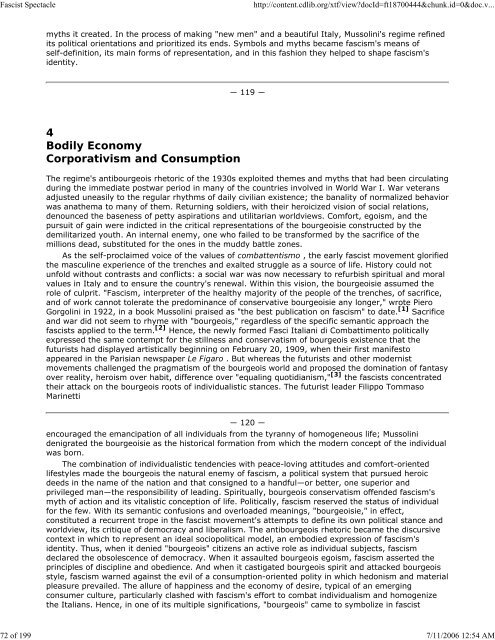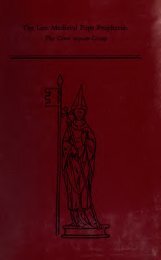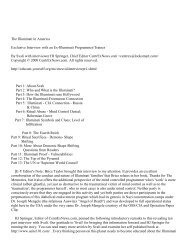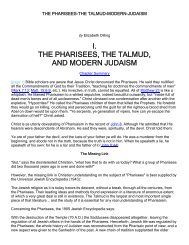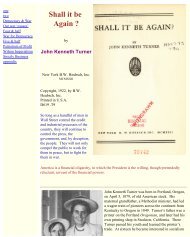Create successful ePaper yourself
Turn your PDF publications into a flip-book with our unique Google optimized e-Paper software.
<strong>Fascist</strong> <strong>Spectacle</strong> http://content.cdlib.org/xtf/view?docId=ft18700444&chunk.id=0&doc.v...<br />
myths it created. In the process of making "new men" and a beautiful Italy, Mussolini's regime refined<br />
its political orientations and prioritized its ends. Symbols and myths became fascism's means of<br />
self-definition, its main forms of representation, and in this fashion they helped to shape fascism's<br />
identity.<br />
4<br />
Bodily Economy<br />
Corporativism and Consumption<br />
― 119 ―<br />
The regime's antibourgeois rhetoric of the 1930s exploited themes and myths that had been circulating<br />
during the immediate postwar period in many of the countries involved in World War I. War veterans<br />
adjusted uneasily to the regular rhythms of daily civilian existence; the banality of normalized behavior<br />
was anathema to many of them. Returning soldiers, with their heroicized vision of social relations,<br />
denounced the baseness of petty aspirations and utilitarian worldviews. Comfort, egoism, and the<br />
pursuit of gain were indicted in the critical representations of the bourgeoisie constructed by the<br />
demilitarized youth. An internal enemy, one who failed to be transformed by the sacrifice of the<br />
millions dead, substituted for the ones in the muddy battle zones.<br />
As the self-proclaimed voice of the values of combattentismo , the early fascist movement glorified<br />
the masculine experience of the trenches and exalted struggle as a source of life. History could not<br />
unfold without contrasts and conflicts: a social war was now necessary to refurbish spiritual and moral<br />
values in Italy and to ensure the country's renewal. Within this vision, the bourgeoisie assumed the<br />
role of culprit. "Fascism, interpreter of the healthy majority of the people of the trenches, of sacrifice,<br />
and of work cannot tolerate the predominance of conservative bourgeoisie any longer," wrote Piero<br />
Gorgolini in 1922, in a book Mussolini praised as "the best publication on fascism" to date. [1] Sacrifice<br />
and war did not seem to rhyme with "bourgeois," regardless of the specific semantic approach the<br />
fascists applied to the term. [2] Hence, the newly formed Fasci Italiani di Combattimento politically<br />
expressed the same contempt for the stillness and conservatism of bourgeois existence that the<br />
futurists had displayed artistically beginning on February 20, 1909, when their first manifesto<br />
appeared in the Parisian newspaper Le Figaro . But whereas the futurists and other modernist<br />
movements challenged the pragmatism of the bourgeois world and proposed the domination of fantasy<br />
over reality, heroism over habit, difference over "equaling quotidianism," [3] the fascists concentrated<br />
their attack on the bourgeois roots of individualistic stances. The futurist leader Filippo Tommaso<br />
Marinetti<br />
― 120 ―<br />
encouraged the emancipation of all individuals from the tyranny of homogeneous life; Mussolini<br />
denigrated the bourgeoisie as the historical formation from which the modern concept of the individual<br />
was born.<br />
The combination of individualistic tendencies with peace-loving attitudes and comfort-oriented<br />
lifestyles made the bourgeois the natural enemy of fascism, a political system that pursued heroic<br />
deeds in the name of the nation and that consigned to a handful—or better, one superior and<br />
privileged man—the responsibility of leading. Spiritually, bourgeois conservatism offended fascism's<br />
myth of action and its vitalistic conception of life. Politically, fascism reserved the status of individual<br />
for the few. With its semantic confusions and overloaded meanings, "bourgeoisie," in effect,<br />
constituted a recurrent trope in the fascist movement's attempts to define its own political stance and<br />
worldview, its critique of democracy and liberalism. The antibourgeois rhetoric became the discursive<br />
context in which to represent an ideal sociopolitical model, an embodied expression of fascism's<br />
identity. Thus, when it denied "bourgeois" citizens an active role as individual subjects, fascism<br />
declared the obsolescence of democracy. When it assaulted bourgeois egoism, fascism asserted the<br />
principles of discipline and obedience. And when it castigated bourgeois spirit and attacked bourgeois<br />
style, fascism warned against the evil of a consumption-oriented polity in which hedonism and material<br />
pleasure prevailed. The allure of happiness and the economy of desire, typical of an emerging<br />
consumer culture, particularly clashed with fascism's effort to combat individualism and homogenize<br />
the Italians. Hence, in one of its multiple significations, "bourgeois" came to symbolize in fascist<br />
72 of 199 7/11/2006 12:54 AM


